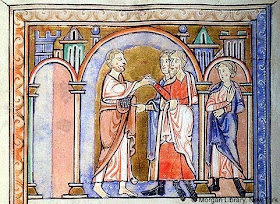 |
| Former Museum of Biblical Art |
Yesterday I received an email from the Museum of Biblical
Art. It was sent to their mailing list and
announced that at the end of the current exhibition, Sculpture in the Age of
Donatello, the museum will close. That
is a very sad situation and says a lot about the current state of affairs in
New York real estate and the dilemma of non-profit institutions. The museum website has the same announcement.
The museum has been in existence for ten years. It was founded to provide a venue for the
study of what has been one of the major themes of Western art for centuries,
biblical stories. It was able to operate because it had a favorable arrangement with the American Bible Society which contributed space in its building on Broadway near Lincoln Center. That landlord-tenant relationship proved to
be a happy one. The museum went on to
host some very interesting and well-received exhibitions, some of which I have
previously written about.
 |
Giovanni D'Ambrogio, Annunciation
Italian, late 14th Century
Florence, Opera di Santa Maria del Fiore |
Now, however, the relationship that allowed the museum to
thrive has turned sour. For various
reasons the American Bible Society decided last year that they would be better
off selling their building and moving out of New York. They have relocated to Philadelphia. Apparently, plans for the move were not
shared with the museum until virtually the last minute, leaving the museum
administration to scramble at short notice to find a new location and the funding
to support it in an overheated real estate climate that is not friendly to an
underfunded non-profit institution in search of a new home. This is a great pity.
The museum will remain open until the end of the current
exhibition on June 14. I saw the
exhibition about a month ago and was overwhelmed by what it contains, in spite
of the fact that there are relatively few pieces on display. But what pieces! I intend to write about it, but want to make
a second visit to absorb more of the details.
However, in the interim, I urge you to go and see it as soon as you
can. It is well worth a visit. It is unfortunate that no future exhibitions
will follow it.





,%20c.%201333-1334_Paris,%20BNF_MS%20Francais%20316,%20fol.%20346r.jpg)

,%20c.%201375_Paris,%20BNF_MS%20Latin%2018014,%20fol.%2076r.jpeg)
,%20c.%201380_Paris,%20BNF_MS%20NAL%203093,%20fol.%20181r.jpg)
,%20c.%201409_Paris,%20BNF_MS%20Latin%20919,%20fol.%2067r.jpg)
,%20c.%201425-1450_Paris,%20BNF_MS%20Francais%20376,%20fol.%20210r.jpg)

,%20End%20of%20the%2015th%20Century_Paris,%20BNF_MS%20Espagnol%20544,%20fol.%2017r.jpeg)


